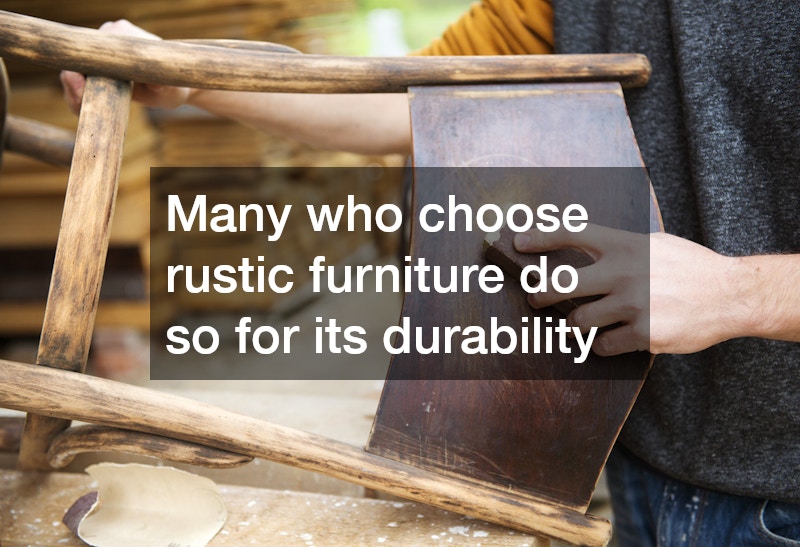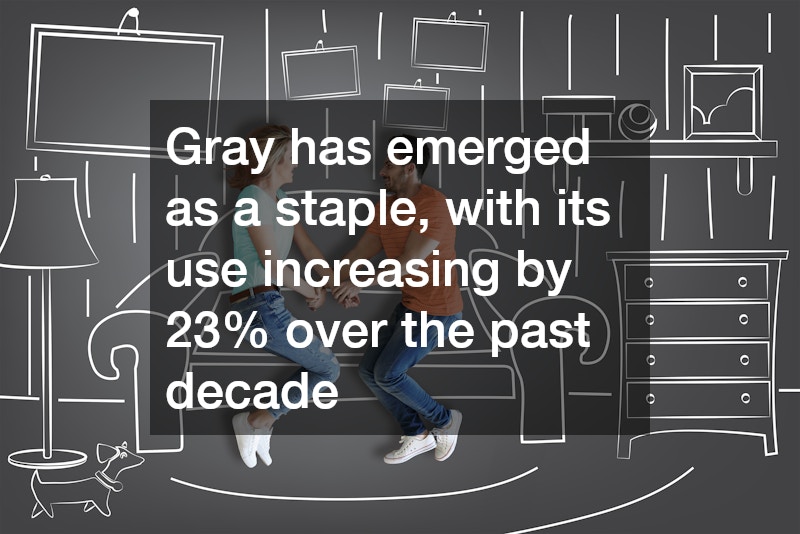If you’re choosing furniture for your new home, you may wonder about trends in furniture design. Not many people can identify eras of furniture design, but some may use those guidelines to help them choose their furniture. For example, you may like the natural appearance of traditional wood furniture. When wooden furniture is combined with colors like greens and browns, it can give your room a forest-like appearance, which might suit you if you love outdoor settings.
Another furniture style that emphasizes wooden furniture is a rustic furniture store. Rustic styles feature the use of wood complemented by “country-style” fabrics and accessories. Many who choose rustic furniture do so for its durability and augment it with brightly colored natural fabrics, as well as farm implements as accessories. This is a popular style in some Midwest homes.

If you like both modern and traditional styles, you can combine those elements. The combination is known as modern traditionalist furniture. This type of style combines the best features of modern and traditional furniture. You might see furniture with the thick curves of traditional furniture side by side with the spare, minimalist lines and colors of contemporary decor.
How we design and decorate our homes has certainly changed over the past decade! The styles and features we see today would have amazed homeowners back in 2010. Old trends got flipped on their head to make way for the modern home.
These days, things like voice control, eco-friendly furniture, and maximizing every inch are the hot trends. Meanwhile, chopped-up rooms and dated color schemes are getting left behind in the dust. Contemporary homes exude a completely new vibe.
In this post, we’ll check out the biggest home design shake-ups between then and now. Get ready for a wild ride through the last decade as we see how much changed in such a short time. Let’s dive in and explore it all!
- Shifting Color Palettes Reflect Changing Tastes
- Open Floor Plans Define Modern Living
- Sustainable Design Becomes a Priority
- Smart Home Technology Transforms Functionality
- Versatile, Multi-functional Furniture Maximizes Small Spaces
- Outdoor Rooms Extend Interior Living Spaces
- The Ongoing Tension Between Minimalism and Maximalism
- Unique Artistic Touches Showcase Personality
- Balancing Innovation With Practicality and Accessibility
- A Sustainable, Technological Future Lies Ahead
- Conclusion
- Frequently Asked Questions
Shifting Color Palettes Reflect Changing Tastes
One of the most noticeable differences is the change in popular color palettes. While neutral tones have risen in popularity, color preferences have diversified beyond beiges.
Gray has emerged as a staple, with its use increasing by 23% over the past decade. It evokes sleek, modern sensibilities.

Blues have made a comeback, with navy and bold cobalt hues adding dramatic splashes of color.
Greens have grown in popularity, with deep forest and light sage tones adding fresh, natural elegance.
This expansion beyond neutrals reflects a desire for personality and flair. The psychology of color plays an important role in shaping the mood of a space.
“Color is such an integral element in design because it has the power to shift the overall feel and atmosphere of a room based on your selection.” – Jonathan Adler, designer
Open Floor Plans Define Modern Living
Open-concept living has become the norm, with 84% of new homes being built with open floor plans. Open designs enhance natural light and promote social interaction between different zones.
This communal style resonates with modern families. When it comes to property management, open designs also pose some unique considerations. Property managers must invest in quality soundproofing materials to reduce noise transfer between units.
Careful tenant screening is key to matching renters who will thrive nearby. Leases may specify that layouts must be maintained. With planning, open-concept homes can be profitable rentals. But conditions for harmonious living must be ensured.
Additionally, the debate continues around privacy and separation. Acoustic planning is required to prevent sound travel. **While openness offers advantages, it also comes with certain compromises.** The appeal lies in community, but separation still matters sometimes.
Sustainable Design Becomes a Priority
The eco-conscious design has taken center stage. Consumers increasingly demand sustainability along with aesthetics.
70% of architects note clients are interested in green building elements.
Sustainable materials like bamboo and cork have become popular.
Energy and water-efficient fixtures are in high demand.
Nowadays, people are more concerned about the environmental impact. The popularity of sustainable design has been bolstered by green building programs. Sustainable homes maximize natural light and airflow. They reduce waste and use local, non-toxic materials. This shrinks the carbon footprint.
The above chart shows how architects are responding to green buildings. The results are clear, green building is growing across the globe. It creates harmony between homes and nature. Sustainable design is good for both the home and the planet.
Smart Home Technology Transforms Functionality
Smart home systems have infiltrated contemporary interiors, with voice assistants, mood lighting, and app-controlled appliances enhancing convenience, security, and entertainment.
The smart home market is projected to reach $174 billion globally by 2025.
Devices like smart thermostats and doorbell cameras are gaining traction, with 45% of Americans already owning smart devices.
This integration of automation allows personalized control over nearly every aspect of the home. With innovations like facial recognition locks and self-recharging robot vacuums, the possibilities are endless. **However, ongoing discussions address risks such as data breaches and over-reliance on technology.**
Versatile, Multi-functional Furniture Maximizes Small Spaces
For urban city dwellers and those embracing minimalism, space-saving furniture with adaptable designs is essential. From collapsible wall beds to tables with built-in storage, multi-functional pieces maximize utility.
The global market for this type of furniture is growing exponentially, with a 7.6% annual growth rate. Their transformative capabilities enable multi-purpose use of tight spaces. Expanding populations and rising property costs have further propelled the need for furniture doing double or triple duty.
Outdoor Rooms Extend Interior Living Spaces
The concept of outdoor living has blossomed over the past decade. Patios, decks, and terraces have evolved from occasional seasonal use into fully realized exterior living rooms.
Contemporary homeowners invest heavily in outdoor furniture, with the market projected to reach $7.5 billion by 2025.
Thoughtful landscape design ties outdoor areas seamlessly into homes, adding an average of 12% to property value.
From outdoor kitchens to lush garden sanctuaries, these spaces cater to our desire for a deeper connection with nature. They provide fresh venues for entertaining and relaxation beyond the confines of interior walls. However, challenges like harsh weather and pest management continue to shape outdoor room design.
The Ongoing Tension Between Minimalism and Maximalism
A spectrum of design philosophies stretch between pared-down, minimalist spaces versus boldly ornamented, maximalist interiors. This dichotomy reveals the unique priorities and lifestyles of different homeowners.
|
Design Style |
Minimalism |
Maximalism |
|
Color Palette |
Neutrals, monochrome |
Vibrant, eclectic |
|
Lines & Shapes |
Simple, clean |
Elaborate, ornamental |
|
Textures |
Smooth, uniform |
Layered, tactile |
|
Accessories |
Sparse, functional |
Abundant, decorative |
|
Overall Look |
Airy, open |
Lavish, intricate |
42% of homeowners report preferring minimalism, expressed through neutral colors, clean lines, and lots of visible negative space.
On the other hand, 38% opt for maximalism, embracing eclectic combinations, striking patterns, and lavish layers of texture.
Our values and aesthetics largely shape these preferences. Minimalists aspire to decluttered, simplistic serenity. For maximalists, design is about saturated visual interest and personalized flair. Both ends of the decorating spectrum offer their unique beauty.
Unique Artistic Touches Showcase Personality
Increasingly, interior design revolves around artistic expression and curated selections that speak to the homeowner’s identity.
64% of homeowners report that original art is very important in home décor.
Displaying personal collections, like books or records, is also popular.
Creativity shines through one-of-a-kind pieces like customized murals or DIY accent walls. These personalized elements convey individuality and ownership of the space. They transform impersonal houses into intimate, welcoming homes.
Balancing Innovation With Practicality and Accessibility
Indeed, cutting-edge design is exciting. But before we get carried away with the latest trends, we should pause and think. Not everyone can afford decking out their home with high-concept finishes. Affordability is a real worry for many folks – 64% say it’s a serious concern.
Pricing people out with design extras doesn’t feel good. Also, progressive doesn’t always mean accessible. We’ve got to consider mobility limitations, aging populations, and people’s unique needs. Good design benefits everyone, not just those with picture-perfect spaces.
A Sustainable, Technological Future Lies Ahead
As home design continues to evolve in the 2020s, technology, and environmental awareness will likely shape its trajectory.
-
With 35 billion Internet of Things devices expected by 2030, automation and smart materials will transform interior functionality.
-
Principles of the circular economy, such as recyclability and renewable resources, will become normalized.
While we can’t foresee exactly what the next decade will herald, the homes of tomorrow are sure to reflect the cultural ethos and values of the era. The unifying thread will be the vision of dwellings adapted for both changing times and enduring human needs. Home design is constantly being reimagined, but always with people at its heart.
Conclusion
As we can see, home design evolves dynamically in step with cultural shifts. Looking back at the trends of the past decade gives us context to understand the present and find inspiration for the future. How have these changes impacted your own home lately? Share your thoughts below!
Frequently Asked Questions
1. How can I add trendy touches to a budget?
Focus on a few key pieces like wall art instead of fully redecorating. Trendy accessories like pillows and prints add style for less.
2. What are easy eco-friendly home ideas?
Use LED lights, low-flow fixtures, green cleaning stuff, and houseplants. Small steps make a difference!
3. Can I mix decor styles well?
Yes! Blend modern, rustic, industrial – whatever you love. Find a harmony between the styles. Eclectic shows creativity.


